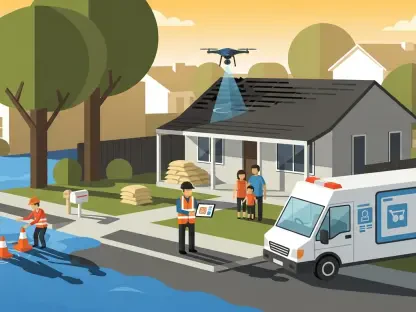In the rapidly evolving landscape of insurance and property restoration, AI technologies are at the forefront, transforming how claims and property damages are assessed and managed. Today, I’m joined by Simon Glairy, a recognized expert in insurance and Insurtech, who will shed light on the impact AI is having within these industries.
Can you explain how AI is currently being used in the property restoration industry?
AI is revolutionizing the property restoration industry by streamlining processes that were traditionally labor-intensive. From damage assessment to project management, AI technologies like image recognition and machine learning are helping restoration companies analyze site conditions more accurately and efficiently. By automating the capture and analysis of photos and videos, these AI tools reduce the time required for inspections and provide consistent data, which is crucial for both insurers and contractors.
How are restoration companies leveraging AI to improve the initial assessment and scoping of property damage?
Restoration companies are utilizing AI to enhance initial assessments by employing image recognition software and mobile applications that capture site conditions in detail. These tools automatically generate preliminary damage estimates and flag irregularities, minimizing manual errors and streamlining the collaboration between adjusters and restoration technicians. The result is a quicker, more accurate assessment that benefits insurers by shortening the overall claims cycle.
In what ways do AI-powered tools like image recognition and 3D modeling enhance the inspection process?
AI-powered image recognition and 3D modeling bring a new level of precision to inspections. These tools can detect and categorize damage types, which means that technicians can assess complex scenarios with greater clarity and less subjective judgment. The detailed visual data supports more informed decision-making processes and helps in generating consistent reports that align with insurer standards.
How can AI in restoration work reduce the time needed for inspections?
AI reduces inspection time by automating tasks that would otherwise require numerous physical evaluations. For instance, real-time image processing and damage recognition allow for immediate feedback and swift damage categorization. This not only speeds up the assessment but also ensures that the data is structured and usable from the get-go, facilitating a smoother progression through the claims process.
What specific benefits do AI tools provide to insurers during the initial claims cycle?
For insurers, AI tools offer the advantage of receiving structured, accurate data early in the claims process. This early insight helps in setting more precise expectations regarding claim resolution timelines and costs. By reducing discrepancies in damage assessments, AI tools also diminish disputes and enhance policyholder satisfaction by delivering a more seamless service experience.
How does AI facilitate better data sharing and transparency between restoration firms and insurance carriers?
AI enhances transparency by enabling seamless data flow between restoration companies and insurers through cloud-based platforms. These systems allow for real-time updates on project status, cost tracking, and documentation uploads, fostering a collaborative environment where all parties have access to the same information. This transparency is key to building trust and ensuring that expectations are consistently met.
Can you elaborate on how cloud-based platforms are improving real-time updates and documentation in restoration projects?
Cloud-based platforms have revolutionized real-time updates and documentation by providing a centralized hub for all project data. Restoration firms can upload photos, reports, and cost estimates that are instantly accessible to insurers. This immediate exchange enables quick adjustments based on real-time information and improves overall project management efficiency.
How do machine learning models help in predicting job timelines and why is this important for insurers?
Machine learning models analyze historical data and current project specifics to predict job timelines more accurately. These predictions allow insurers to manage resources better, forecast claim settlements, and enhance customer service by setting realistic expectations for policyholders. Knowing how long a restoration might take helps insurers manage their workflows effectively.
What are the typical discrepancies between adjuster estimates and restoration invoices, and how does AI help reduce these disputes?
Discrepancies often arise from differing assessments of the extent of damage and costs involved. AI helps reduce these disputes by standardizing the scoping process with tools that align estimates from both adjusters and restorers. By using shared pricing databases, these technologies ensure that all parties work with the same cost parameters, significantly reducing potential conflicts.
How do standardized AI-assisted scoping tools align restoration firms with insurer expectations?
Standardized AI-assisted scoping tools provide a framework that aligns the damage assessments of restoration firms closely with insurer expectations. These tools leverage databases for reference pricing and generate estimates that can be seamlessly integrated into insurers’ claims systems, fostering a more unified approach to claims management and reducing friction in negotiations.
What role do predictive analytics play in anticipating trends within the restoration industry?
Predictive analytics is pivotal in helping restoration companies anticipate future trends such as potential demand spikes or resource allocation needs. By analyzing patterns in weather data, claim volumes, and geography, restoration firms can better prepare for events like natural disasters, ensuring they are more responsive and equipped to handle surges efficiently.
How can insurers utilize predictive insights from restoration companies to improve their own processes?
Insurers can leverage predictive insights from restoration firms to enhance their risk assessment models and customer communication strategies. These insights can help in predicting loss events, improving underwriting accuracy, and implementing proactive measures like pre-loss mitigation to better serve policyholders and manage potential claims.
What are some examples of pre-loss mitigation efforts that might arise from partnerships between insurers and restorers?
Pre-loss mitigation efforts could include proactive measures like installing sensors to detect leaks or developing better fire prevention strategies based on predictive analytics. Such partnerships leverage shared data to identify high-risk areas or vulnerable properties, enabling insurers and restorers to collaborate on reducing potential losses even before incidents occur.
What ethical considerations should restoration firms be aware of when implementing AI technologies?
Restoration firms must ensure that AI technologies are deployed ethically, avoiding any reinforcement of biases or unfair practices. It’s crucial to maintain human oversight in areas where AI decisions could impact customer well-being. Firms should strive for transparency in how data is used and ensure that their systems prioritize privacy and security.
Why is human oversight still critical in the use of AI in property restoration?
Human oversight is essential because AI, while powerful, can sometimes misinterpret complex situations that require nuanced judgment. Experienced professionals need to make critical decisions, especially those involving significant financial implications or customer well-being. Human intuition and expertise provide a safeguard against reliance solely on automated processes.
In what ways can insurers and restoration companies collaborate to make better use of AI technologies?
Collaboration between insurers and restoration companies can take the form of shared platforms, joint training programs, and integrated technology solutions that streamline workflows. By aligning goals such as improving efficiency and customer satisfaction, both parties can maximize the benefits of AI, ensuring that systems are effectively meeting industry standards.
How can AI transform the customer experience during the claims process?
AI can significantly enhance the customer experience by providing quicker, more accurate assessments, reducing wait times, and improving communication. With AI, customers receive more transparent updates and faster service resolution, leading to higher satisfaction levels and reinforcing trust in both insurers and restoration service providers.
Ultimately, how does AI empower professionals in the restoration industry rather than replace them?
AI empowers restoration professionals by providing them with advanced tools that enhance their capabilities. It reduces the time spent on routine tasks, allowing them to focus on high-value activities like strategic planning and customer interaction. AI acts as a complementary force, boosting human expertise rather than replacing it.
What are the long-term implications for insurers who do not adopt AI and digital tools in their processes?
Insurers who resist adopting AI and digital tools may find themselves at a competitive disadvantage. Without these technologies, they risk falling behind in efficiency, accuracy, and customer satisfaction. As the industry moves towards digital transformation, staying current with these advancements is crucial for maintaining market relevance and delivering value to policyholders.









